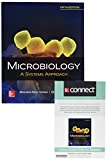
GEN COMBO LOOSELEAF MICROBIOLOGY:A SYSTEMS APPROACH; CONNECT ACCESS CARD
5th Edition
ISBN: 9781260149364
Author: Marjorie Kelly Cowan Professor
Publisher: McGraw-Hill Education
expand_more
expand_more
format_list_bulleted
Concept explainers
Question
Chapter 12.3, Problem 15AYP
Summary Introduction
To name:
Two drugs that target the cellular membrane.
Concept introduction:
Antimicrobial drugs differ in its mode of action, including inhibition of cell wall, inhibition of protein and
Expert Solution & Answer
Want to see the full answer?
Check out a sample textbook solution
Students have asked these similar questions
What is the structure and function of Eukaryotic cells, including their organelles? How are Eukaryotic cells different than Prokaryotic cells, in terms of evolution which form of the cell might have came first? How do Eukaryotic cells become malignant (cancerous)?
What are the roles of DNA and proteins inside of the cell? What are the building blocks or molecular components of the DNA and proteins? How are proteins produced within the cell? What connection is there between DNA, proteins, and the cell cycle? What is the relationship between DNA, proteins, and Cancer?
Why cells go through various types of cell division and how eukaryotic cells control cell growth through the cell cycle control system?
Chapter 12 Solutions
GEN COMBO LOOSELEAF MICROBIOLOGY:A SYSTEMS APPROACH; CONNECT ACCESS CARD
Ch. 12.1 - State the main goal of antimicrobial treatment.Ch. 12.1 - Identify sources of the most commonly used...Ch. 12.1 - Summarize two methods for testing antimicrobial...Ch. 12.1 - Prob. 4AYPCh. 12.2 - Prob. 5AYPCh. 12.2 - Describe the five major targets of antimicrobial...Ch. 12.2 - Identify which categories of drugs are most...Ch. 12.3 - Prob. 8AYPCh. 12.3 - Trace the development of penicillin...Ch. 12.3 - Prob. 10AYP
Ch. 12.3 - Prob. 11AYPCh. 12.3 - Prob. 12AYPCh. 12.3 - Prob. 13AYPCh. 12.3 - Identify the cellular target of quinolones, and...Ch. 12.3 - Prob. 15AYPCh. 12.3 - Prob. 16AYPCh. 12.3 - Prob. 17AYPCh. 12.3 - Prob. 18AYPCh. 12.3 - Describe two major modes of action of antiviral...Ch. 12.4 - Prob. 20AYPCh. 12.4 - Prob. 21AYPCh. 12.4 - Discuss at least three novel antimicrobial...Ch. 12.5 - Distinguish between drug toxicity and allergic...Ch. 12.5 - Prob. 24AYPCh. 12 - Prob. 1MCQCh. 12 - Prob. 2MCQCh. 12 - Prob. 3MCQCh. 12 - Microbial resistance to drugs is acquired through...Ch. 12 - Prob. 5MCQCh. 12 - Prob. 6MCQCh. 12 - Prob. 7MCQCh. 12 - Which of the following modes of action would be...Ch. 12 - Prob. 9MCQCh. 12 - Prob. 10MCQCh. 12 - Prob. 11TFCh. 12 - Prob. 12TFCh. 12 - Biofilms are difficult to treat and do not always...Ch. 12 - Prob. 14TFCh. 12 - Prob. 15TFCh. 12 - Construct a paragraph describing the...Ch. 12 - Prob. 2CTQCh. 12 - Antibiotic-resistance genes, as well as other...Ch. 12 - Prob. 4CTQCh. 12 - What is the significance of the bottom row in...Ch. 12 - Figure 12.5. Where could penicillinase affect each...Ch. 12 - From chapter 6, process figure 6.14a. Describe as...Ch. 12 - Prob. 1CM
Knowledge Booster
Learn more about
Need a deep-dive on the concept behind this application? Look no further. Learn more about this topic, biology and related others by exploring similar questions and additional content below.Similar questions
- In one paragraph show how atoms and they're structure are related to the structure of dna and proteins. Talk about what atoms are. what they're made of, why chemical bonding is important to DNA?arrow_forwardWhat are the structure and properties of atoms and chemical bonds (especially how they relate to DNA and proteins).arrow_forwardThe Sentinel Cell: Nature’s Answer to Cancer?arrow_forward
- Molecular Biology Question You are working to characterize a novel protein in mice. Analysis shows that high levels of the primary transcript that codes for this protein are found in tissue from the brain, muscle, liver, and pancreas. However, an antibody that recognizes the C-terminal portion of the protein indicates that the protein is present in brain, muscle, and liver, but not in the pancreas. What is the most likely explanation for this result?arrow_forwardMolecular Biology Explain/discuss how “slow stop” and “quick/fast stop” mutants wereused to identify different protein involved in DNA replication in E. coli.arrow_forwardMolecular Biology Question A gene that codes for a protein was removed from a eukaryotic cell and inserted into a prokaryotic cell. Although the gene was successfully transcribed and translated, it produced a different protein than it produced in the eukaryotic cell. What is the most likely explanation?arrow_forward
- Molecular Biology LIST three characteristics of origins of replicationarrow_forwardMolecular Biology Question Please help. Thank you For E coli DNA polymerase III, give the structure and function of the b-clamp sub-complex. Describe how the structure of this sub-complex is important for it’s function.arrow_forwardMolecular Biology LIST three characteristics of DNA Polymerasesarrow_forward
arrow_back_ios
SEE MORE QUESTIONS
arrow_forward_ios
Recommended textbooks for you
- Essentials of Pharmacology for Health ProfessionsNursingISBN:9781305441620Author:WOODROWPublisher:Cengage
 Principles Of Radiographic Imaging: An Art And A ...Health & NutritionISBN:9781337711067Author:Richard R. Carlton, Arlene M. Adler, Vesna BalacPublisher:Cengage Learning
Principles Of Radiographic Imaging: An Art And A ...Health & NutritionISBN:9781337711067Author:Richard R. Carlton, Arlene M. Adler, Vesna BalacPublisher:Cengage Learning


Essentials of Pharmacology for Health Professions
Nursing
ISBN:9781305441620
Author:WOODROW
Publisher:Cengage


Principles Of Radiographic Imaging: An Art And A ...
Health & Nutrition
ISBN:9781337711067
Author:Richard R. Carlton, Arlene M. Adler, Vesna Balac
Publisher:Cengage Learning


Drug Abuse, Causes, Signs and Symptoms, Diagnosis and Treatment.; Author: Medical Centric;https://www.youtube.com/watch?v=b6Dte96WdqM;License: Standard youtube license